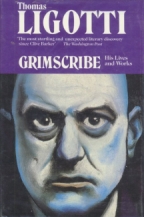Grimscribe: His Lives and Works
Thomas Ligotti
Carroll & Graf
US Hardcover First
ISBN 0-88184-739-9
213 pages ; $20.95
Date Reviewed: 02-15-1992
Reviewed by Rick Kleffel © 2002

REFERENCES
COLUMNS
|
|
|
Grimscribe: His Lives and WorksThomas LigottiCarroll & GrafUS Hardcover FirstISBN 0-88184-739-9213 pages ; $20.95Date Reviewed: 02-15-1992Reviewed by Rick Kleffel © 2002 |
|
|
REFERENCES |
COLUMNS |
In the plot-driven world of modern publishing, tension has replaced terror as the primary component of modern horror. Poe and Lovecraft, at their best, were masters of terror; you were afraid to read what they were willing to suggest. In "Grimscribe: His Lives and Works", by Thomas Ligotti, we can once again experience the thrill of pure, undiluted terror and shockingly beautiful prose.
"Grimscribe" is the name Ligotti gives his voice, the source of this wondrous prose. It is not necessarily a single person, but a way of seeing, a connection between the dark, sweet places of the soul and the printed page. "I know his voice, I hear it speak, because it is always speaking of terrible secrets. That is one thing I can never disguise, even if it sounds like many voices," he tells us in the Introduction. This makes "Grimscribe: His Lives and Works" not so much a collection of connected stories as a series of eerie choruses, subtle variations of the themes of darkness, decay, death and the terror of the unknowable. Unlike most of today's horror writers, who use a more anatomical approach, Ligotti consciously and successfully raises his perceptions of death and decay to the plane of the abstract and the academic, shrouding them in a delicious, dank, elegant prose.
In keeping with the elevated tone of the prose, the plots of the stories in "Grimscribe" tend towards the understated and anecdotal, but Ligotti's talent for a turn of the phrase ensures that they're as engrossing as they are elegiac. In "Nethescurial", the narrator receives a letter from a friend who has come upon a particularly disturbing manuscript, one which suggests the reader "Imagine all of creation as a mere mask for foulest evil, an absolute evil whose reality is mitigated only by our blindness to it, an evil at the heart of things...of course, we do need to keep a distance from such spectres as Nethescurial, but this is usually provided by the medium of words...and yet the words of this particular manuscript seem rather weak in this regard..." The narrator dreams to find himself trapped in a Kafka-esque librarian's nightmare, from which he emerges to find that "I could also see what was squirming beneath every surface, my vision penetrating through the usual armor of objects and discerning the same gushing stuff inside whatever I looked upon.."
Ligotti's greatest strength as a horror writer is in what he chooses to show the reader. His prose is at its best, its most emotive, when he is creating an image of terror, suggesting something that the reader would rather not have clearly defined. In "Flowers From the Abyss", our narrator is sent as an emissary to speak to a man who keeps an unsavory garden. Grimscribe's night-time tour of a six by six plot is not one the reader will soon forget. "With the darkness I saw the darkness...But there were also things within the darkness, within me and outside of me, so that if I reached out to touch them across a universe of darkness, I also reached deep inside this body. But all I could feel were the flowers themselves: to touch them was like touching light and touching colors and a thousand kinds of bristling and growing shapes...In all that darkness which gave me breath and let me see with itself, these things squirmed and fought against me. I cannot explain why they were there, but it sickened me that anything had to be there and more so because it was these flowers, which were like a great mass of maimed things writhing upon the shore of a beautiful dark sea."
Fortunately, Ligotti keeps the tone varied, and mixes charm with fear in stories like "Miss Plarr", which recounts the childhood of our narrator and his most peculiar tutor. "For instance, she returned time and time again to the earliest twitchings of human life, portraying a world of only the most rudimentary law, but one so intriguingly advanced in what she called 'visceral practices'." The final story, "The Shadow at the Bottom of the World" describes a town where the colors of autumn linger long past their welcome, and take on an unhealthy hue and become "fluttering scraps of lush color..the pages of a secret book..." In "Grimscribe", Thomas Ligotti manages to write that secret book, presenting us with stories that are paradoxically beautiful and horrific, the marriage of gorgeous prose and a macabre imagination.